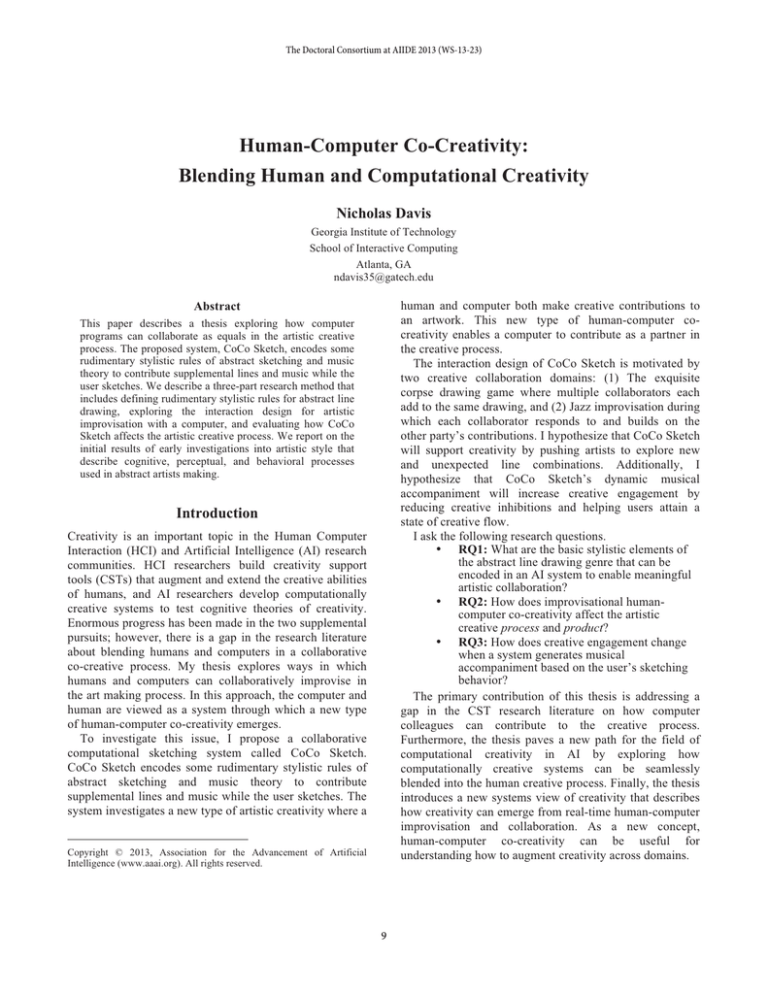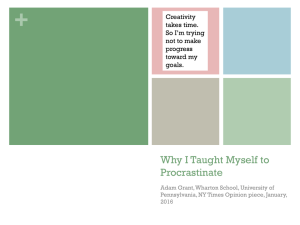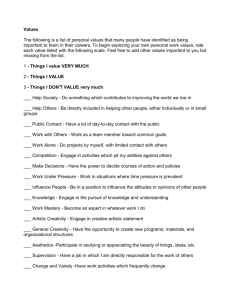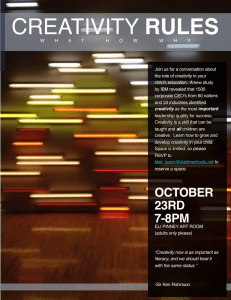
The Doctoral Consortium at AIIDE 2013 (WS-13-23)
Human-Computer Co-Creativity:
Blending Human and Computational Creativity
Nicholas Davis
Georgia Institute of Technology
School of Interactive Computing
Atlanta, GA
ndavis35@gatech.edu
human and computer both make creative contributions to
an artwork. This new type of human-computer cocreativity enables a computer to contribute as a partner in
the creative process.
The interaction design of CoCo Sketch is motivated by
two creative collaboration domains: (1) The exquisite
corpse drawing game where multiple collaborators each
add to the same drawing, and (2) Jazz improvisation during
which each collaborator responds to and builds on the
other party’s contributions. I hypothesize that CoCo Sketch
will support creativity by pushing artists to explore new
and unexpected line combinations. Additionally, I
hypothesize that CoCo Sketch’s dynamic musical
accompaniment will increase creative engagement by
reducing creative inhibitions and helping users attain a
state of creative flow.
I ask the following research questions.
• RQ1: What are the basic stylistic elements of
the abstract line drawing genre that can be
encoded in an AI system to enable meaningful
artistic collaboration?
• RQ2: How does improvisational humancomputer co-creativity affect the artistic
creative process and product?
• RQ3: How does creative engagement change
when a system generates musical
accompaniment based on the user’s sketching
behavior?
The primary contribution of this thesis is addressing a
gap in the CST research literature on how computer
colleagues can contribute to the creative process.
Furthermore, the thesis paves a new path for the field of
computational creativity in AI by exploring how
computationally creative systems can be seamlessly
blended into the human creative process. Finally, the thesis
introduces a new systems view of creativity that describes
how creativity can emerge from real-time human-computer
improvisation and collaboration. As a new concept,
human-computer co-creativity can be useful for
understanding how to augment creativity across domains.
Abstract
This paper describes a thesis exploring how computer
programs can collaborate as equals in the artistic creative
process. The proposed system, CoCo Sketch, encodes some
rudimentary stylistic rules of abstract sketching and music
theory to contribute supplemental lines and music while the
user sketches. We describe a three-part research method that
includes defining rudimentary stylistic rules for abstract line
drawing, exploring the interaction design for artistic
improvisation with a computer, and evaluating how CoCo
Sketch affects the artistic creative process. We report on the
initial results of early investigations into artistic style that
describe cognitive, perceptual, and behavioral processes
used in abstract artists making.
Introduction
Creativity is an important topic in the Human Computer
Interaction (HCI) and Artificial Intelligence (AI) research
communities. HCI researchers build creativity support
tools (CSTs) that augment and extend the creative abilities
of humans, and AI researchers develop computationally
creative systems to test cognitive theories of creativity.
Enormous progress has been made in the two supplemental
pursuits; however, there is a gap in the research literature
about blending humans and computers in a collaborative
co-creative process. My thesis explores ways in which
humans and computers can collaboratively improvise in
the art making process. In this approach, the computer and
human are viewed as a system through which a new type
of human-computer co-creativity emerges.
To investigate this issue, I propose a collaborative
computational sketching system called CoCo Sketch.
CoCo Sketch encodes some rudimentary stylistic rules of
abstract sketching and music theory to contribute
supplemental lines and music while the user sketches. The
system investigates a new type of artistic creativity where a
Copyright © 2013, Association for the Advancement of Artificial
Intelligence (www.aaai.org). All rights reserved.
9
not completely dictated by the programmer, which makes
its process more creative.
The proposed project injects human creativity into the
algorithms of a computationally creative system. Instead of
random number generators introducing noise in the system
to drive unpredictable results, the system will leverage the
human’s creative contributions as input to the system. In
this context, the focus is not on building a sufficiently
creative computational system, but rather by enabling a
creative system that includes both a human actor and
distributed algorithms that process input independently.
Related Work
Creativity Support Tools
Creativity Support Tools (CSTs) enhance and augment the
user’s existing creative skills. The precise functionality of
CSTs change based on creative domain, but they generally
allow users to rapidly generate multiple alternatives,
explore and simulate choices, and revert to earlier stages of
an idea (Schneiderman 2007). Currently, most CSTs allow
users to perform operations on their creative product and
support decision-making about that product. Lubart (2005)
enumerates four categories that describe how computers
can support creativity. A computer nanny provides tools to
schedule and maintain creative activities. A computer penpal supports collaboration within teams. Computer coaches
stimulate creative thinking by suggesting creative activity
based on expert knowledge in the domain. Computer
colleagues may meaningfully contribute to tasks so a
human-computer team becomes a contributor to a domain.
This last category of CSTs, computer colleagues, offers
interesting opportunities for creative expression, but it has
not been researched very deeply.
There are several artistic and sketching related CSTs that
teach technical skills or stimulate creative thinking. For
example, iCanDraw helps users draw realistic portraits by
providing feedback about the accuracy of user’s lines
according to an expertly drawn portrait that serves as the
ground truth (Dixon et al. 2010). iCanDraw and other
similar systems improve the user’s technical artistic ability,
but none of these types of computational systems make
creative contributions to the artwork itself.
Co-Creativity
Co-creativity is classified as multiple parties contributing
to the creative process in a blended manner (Candy et al.
2002). In alternative creative situations, tasks can be
accomplished through a distribution of labor, but the result
only represents the sum of each individual contribution.
Co-creativity goes beyond this division of labor model and
allows all individuals to contribute collaboratively and
synthetically. In this situation, ideas can be fused,
combined, merged, and added onto in ways that stem from
the unique mix of personalities and motivations of the team
members (Candy et al. 2002). It can yield more creative
solutions than if each party completed an isolated task and
then added them together, i.e. the sum is greater than the
parts.
I introduce a new term called human-computer cocreativity that introduces a computer into this collaborative
environment as an equal in the creative process. Depending
on the implementation details, the computer can potentially
collaborate with the user in a variety of ways. The crucial
point here is that the computer does not follow a predefined script to guide the interaction. The program is
adapting to the input of the user and generating responses
to that input based on computationally creative algorithms.
Human-computer co-creativity describes a situation in
which the human and computer improvise in real time to
generate a creative product. Here, creativity emerges
through the interaction of both the human and the
computer. This model of interaction is not a distribution of
labor where each party performs different and independent
tasks. The contributions of human and computer are
mutually influential, which is the nature of collaboration
and improvisation.
Computational Creativity
Creativity is generally defined as a product that is novel,
valuable, and surprising (Sternberg 2006). The field of
computational creativity develops computer programs that
autonomously produce works of art that are classified as
creative. Harold Cohen (McCorduck 1990) developed a
computer program called Aaron that creates brightly
colored digital artworks containing abstract shapes and
human figures. Aaron’s algorithms are non-deterministic,
which means the initial conditions and subsequent
decisions of the system greatly influence the product. The
product cannot be predicted because it does not follow a
linear path, which means the artworks that Aaron produces
are both novel and surprising. Furthermore, these artworks
have demonstrated value through their acceptance as art
that is displayed in galleries.
Colton (2008) pushed the field of computational
creativity forward when he suggested that creativity should
be measured through process as well as product. For
example, Aaron’s software architecture uses distributed
processing where many different models analyze the each
other’s decisions and reacts to them in unique ways. These
modules all interact to yield an emergent artwork that was
Research Method
The method for this thesis is threefold. (1) Perform
qualitative empirical studies to begin to understand
rudimentary stylistic elements of abstract drawings. (2)
Encode those stylistic rules into algorithms and work to
define the proper interaction design for CoCo Sketch
through iterative prototyping and user testing. (3) Evaluate
whether the prototype answers the hypotheses by
10
measuring its effect on the creative process of artists. The
next sections will explain these three components in more
detail.
Some abstract artists alternate their focus and perception
between local features, regional patterns, and global
relationships throughout their process. Local features refer
to individual lines and their visual appearance. Regional
patterns describe how lines and groups of lines interact and
form coherent patterns. Global relationships describe the
ways in which different parts of the drawing relate to each
other and how to make a coherent overall composition.
Local, regional, and global components all have
independent and sometimes overlapping evaluation
criteria. Each aspect of the artwork has what can be
referred to as an aesthetic equilibrium that is reached by
elaborating on the existing structures until they reach a
state of stylistic ‘maturity,’ meaning that the lines adhere to
some internal set of aesthetic or perceptual logic (Davis et
al. 2011). For example, sketchy lines may need to be made
smooth, or skinny lines may need to be made thick in order
for aesthetic equilibrium to be reached.
Further analysis is needed to fully address RQ1 and
create a more robust and detailed understanding of the
creative process of abstract artists. Once some rudimentary
stylistic rules exist, the improvisational structure and
interaction design of CoCo Sketch needs to be developed.
Encoding Artistic Style
Defining general rules that describe artistic style is a
complex pursuit. Scoping the aim of this task significantly
simplifies it. For the purposes of this project, I will focus
exclusively on abstract line drawings. Complex shapes,
such as people and animals, add a significant amount of
difficulty due to the complexity of computer vision and
object recognition. By focusing on abstract line drawing,
the rules only need to deal with the visual features of lines
and their spatial relations. Furthermore, an exhaustive and
generalized catalog of artistic style in this domain is not
necessary because the system only needs enough domain
knowledge to make meaningful contributions. Fortunately,
abstract art is forgiving in the sense that contributions from
the computer will not be ‘wrong’ in the same way that they
would be in representational art, i.e. putting an ear where a
nose should be.
Three methods will be used to collect data about artistic
style. The first step is making video records of abstract
artists creating line drawings. After the artist is finished,
they will be complete a retrospective protocol analysis
describing their thoughts and motivations that guided their
stylistic decisions. Performing a qualitative data analysis of
this footage will help determine patterns and themes that
can be used to describe the decision making process of
artists. For example, does the artist have a certain strategy
for making contributions, such as defining major lines and
then adding details to those lines later? Does this strategy
change as the artwork progresses?
Next, the artists will engage in a more controlled task
where they create response lines to a pre-determined set of
inputs consisting of simple shapes, such as vertical and
horizontal lines, circles, and squares in different positions
on a piece of paper (Davis et al. 2011). Asking the artist to
draw response lines and explain their reasoning will help
isolate factors that influence their decision making process.
Finally, the artists will play a collaborative art game
(Hsiao et al 2013). In this game, the artist has to teach an
‘apprentice’ how to draw in a way that looks like the
artist’s style. Interaction will occur through turn taking,
and the artist will be asked to provide feedback to about
the apprentice’s contributions, such as what was done right
or wrong. This exercise will force the artist to be explicit
about the rules and procedures s/he uses to make artistic
decisions and help codify elements of artistic style.
Preliminary analysis of the abstract art creative process
reveals two fundamental types of contributions in an
abstract artwork—contributions that elaborate and refine
an existing structure, and contributions that catalyze the
artwork (Davis et al. 2011). Elaborations build on existing
lines and patterns, whereas catalysts introduce completely
new themes and structures into the piece.
Designing for Improvised Interaction
A semiotic analysis of the communication structure in
improvisation will help inform the interaction dynamics
and functions of the system. The most basic definition will
be that of a creative trajectory, which is the shared
understanding and intention to make creative contributions
in a mutually negotiated and desired direction.
There are many ways that computers can improvise with
humans in the artistic creative process. Improvisation
includes understanding and relating to the contributions of
another party. In successful improvisation, an individual is
able to discern a pattern or theme and respond to that
theme in a meaningful way. This is the basic call and
response format in jazz improvisation. I will begin the
analysis from this starting point.
Contributions that serve to establish a pattern or theme
will be called establishing actions. This is similar to
choosing a topic in a conversation. One party picks a
creative trajectory and executes an initial action in that
trajectory. The degree of expressivity, detail, or clarity of
the establishing action will influence the interpretation of
this action. For example, if the establishing action is too
small or ambiguous, the other party may not understand
how to contribute to it. When a party observes and
experiences an establishing action, the choice is to accept
that trajectory and align their subsequent actions with that
pattern or reject it. A response action that accepts the
suggested creative trajectory will be called a verification
action, while a response that rejects a creative trajectory
will be referred as a rejection action.
An improvisatory action that verifies a pattern shows
that the party was able to successfully interpret a pattern or
part of a pattern. Additionally, it encodes a value judgment
11
on the part of the responder that shows that the party
agrees with the suggested direction. Verification actions
will typically align with the interpreted pattern or theme.
This serves two purposes: 1) Testing whether the
interpreted theme or pattern as the intended them or
pattern, and 2) Indicating support for the established
theme. When the initiating party experiences the
verification action, they can verify that the theme was
interpreted correctly and perform building actions that add
to an established theme. At this point both parties are on
similar creative trajectories and can perform small
elaboration actions that push the established boundaries of
the current theme.
At any point during the creative trajectory, a party can
choose to break the current communication channel and
open up an alternative channel of communication to
establish a new theme or pattern of collaboration. This type
of action is termed a deviation action. A deviation action
serves a double purpose of notifying the other party of the
intention to deviate from the current creative trajectory as
well as suggesting a new direction by trying to establish a
new theme. Deviation actions can serve as catalysts to the
creative process because they force the other party to
respond in a creative way.
Deviation actions can disturb an established equilibrium
of a local area, region, or the global artwork. CoCo Sketch
will separate state data for local, regional, and global
information. The decision engine determining how CoCo
Sketch will respond incorporates the improvisational
semiotics outlined in this section as well as the
rudimentary stylistic guidelines described earlier.
creative flow. Finally, the creative products for each three
drawings will be given to an expert panel to evaluate their
creativity using Amabile’s Consensual Assessment
Technique (1996).
Conclusions
This thesis addresses a gap in the research literature about
computers colleagues that contribute as equals in the
creative process. Human-computer co-creativity offers
interesting possibilities in the fields of computational
creativity as well as creativity support tools because it
seamlessly integrates human and computational creativity.
The research program that we presented included three
components that deal with learning about artistic style,
encoding those stylistic rules and defining the interaction,
and finally evaluating the system.
References
Amabile, T. M., Creativity in Context. 1996. Westview Press:
Boulder.
Candy, L., & Edmonds, E. Modeling co-creativity in art and
technology. Proc. of Creativity & Cognition ‘02, (2002), 134141.
Carroll, E.A., Latulipe, C., Fung, R., and Terry, M. Creativity
factor evaluation: towards a standardized survey metric for
creativity support. Proc. of Creativity & Cognition ‘09, (2009),
127–136.
Colton, S. Creativity Versus the Perception of Creativity in
Computational Systems. New Generation Computing, (2008), 14–
20
Davis, N., Gupta, P. Gupta, S., Do, Ellen Y.-L. Computing
harmony with PerLogicArt: Perceptual Logic Inspired
Collaborative Art. Proc. of Creativity & Cognition ‘11, (2011),
185-194.
Dixon, D., Prasad, M., & Hammond, T. (2010). iCanDraw: using
sketch recognition and corrective feedback to assist a user in
drawing human faces. Proc. of CHI, (2010), 897-906.
Hsiao, C.-P., Davis, N., Chen, S., Sun, B., Chen, R., and Do,
Ellen Y.-L. Sketch Master – A Sketch Game for Collecting
Exploratory Data. Proc. of Creativity and Cognition 13’ (2013).
Lubart, T. How can computers be partners in the creative process:
Classification and commentary on the Special Issue. International
Journal of Human-Computer Studies 63, 4-5 (2005), 365–369.
McCorduck, P. Aaron’s Code: Meta-Art, Artificial Intelligence
and the Work of Harold Cohen. 1990. W H Freeman & Co.: San
Francisco.
Sternberg, R.J. The nature of creativity. Creativity Research
Journal 18, 1 (2006), 87–98.
Shneiderman, B. Creativity support tools: accelerating discovery
and innovation. Communications of the ACM, 50, 12 (2007), 2032.
Evaluation
The mixed-method evaluation consists of three phases that
include both quantitative and qualitative elements. To
evaluate CoCo Sketch, 10 abstract artists will create three
ten-minute sketches with CoCo Sketch. The first sketch
will be the control condition with no assistance. The
second sketch will improvise and collaborate with the user,
and the third sketch will improvise as well as provide
musical accompaniment.
The CoCo Sketch tool will log sketch behavior and
provide quantitative data, such as the number of lines,
amount of ink per second, time lapse between lines, and
average line length. This quantitative data can be used as
one indication of how the different interventions affect
sketching behavior, which addresses part of RQ2 about the
creative process. Artists will be asked to perform a
retrospective protocol analysis to describe their experience
and thought processes for each of the conditions to provide
qualitative insight about how the tool affected their
creative process.
The participants will also complete the Creativity
Support Index (Carol et al. 2009), which provides
measurements about creative engagement. This will help
answer RQ3 about whether CoCo Sketch helps cultivate
12








